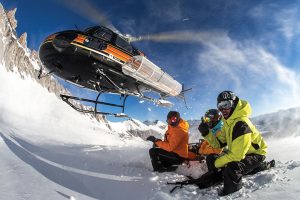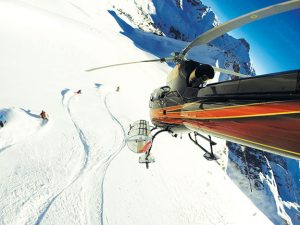By Ted Christodulidis
For some, a holiday mountainside retreat is an established tradition. To breathe a different air and see a different sky, and for most, to seek out the freshest powder no cannon or resort could offer. Skiing, as we know it today, experienced its beginnings in Scandinavia and was practiced as long ago as 600 BC in what is modern-day China. Until the 1850s, skiing was used as a primary form of transportation in nordic communities, with records of military ski competitions being held in Norway as far back as the 1700s. Skiing has surely overgone an extensive evolution since then, becoming a popular winter sport and recreational activity along the way; although certainly not without reason.
Through advances in a range of factors, progressive methods of skiing have exploded in popularity during the past two decades. One, in particular, being sought out by enthusiasts the world over is called heli-skiing. This involves piloting a helicopter to areas a long distance from any resort and riding down unmarked and ungroomed natural terrain. For over thirty years, Telluride Helitrax in Colorado has ventured daily into the San Juan mountain range, seeking the most beautiful and untouched lines for their guests. Helitrax’s Program Director, Joe Shults, took a moment to further explain some of the finer details pertaining to the sport.
 When asked about his first heli-skiing experience, Shults reminisced like it was yesterday: “The sky out there, it’s a deeper, more pure blue; simply a crystal blue day, with probably two feet of virgin powder. You’re in the helicopter heading towards the peaks with an unrepressed smile from ear to ear. I’d already experienced a variety of terrain, but couldn’t contain the excitement of that day. After grabbing the gear, the helicopter takes off, blowing all the snow around like a fresh blizzard. That’s when it hits you: ‘I’m really doing this. At 12,000 feet. No lines. No lifts. No crowds. Nothing will get in my way…’ Exhilarating would almost be an understatement.” He explained that while skiing is the obvious focus of the trip, it’s a truly overwhelming experience that goes far beyond simply strapping in and descending; somewhere in a valley, surrounded by three feet of snow and gargantuan peaks taller than any man-made structure, does the realization of our own insignificance truly set upon us. It’s both an emotional and personal moment that is exceptionally difficult to recreate elsewhere.
When asked about his first heli-skiing experience, Shults reminisced like it was yesterday: “The sky out there, it’s a deeper, more pure blue; simply a crystal blue day, with probably two feet of virgin powder. You’re in the helicopter heading towards the peaks with an unrepressed smile from ear to ear. I’d already experienced a variety of terrain, but couldn’t contain the excitement of that day. After grabbing the gear, the helicopter takes off, blowing all the snow around like a fresh blizzard. That’s when it hits you: ‘I’m really doing this. At 12,000 feet. No lines. No lifts. No crowds. Nothing will get in my way…’ Exhilarating would almost be an understatement.” He explained that while skiing is the obvious focus of the trip, it’s a truly overwhelming experience that goes far beyond simply strapping in and descending; somewhere in a valley, surrounded by three feet of snow and gargantuan peaks taller than any man-made structure, does the realization of our own insignificance truly set upon us. It’s both an emotional and personal moment that is exceptionally difficult to recreate elsewhere.
However, those still abiding by “pizza french fries” should refrain from accepting such a challenge just yet. Shults laid out that skiers should be performing at an intermediate to advanced level, with the capability of managing an ungroomed black diamond run and understanding the fall line (the line most directly downhill) of the mountain. As snowboarding in powder conditions tends to be both more difficult and complicated, it’s recommended riders be of a higher-advanced level. Shults also regarded that while a hunger for adventure is hugely important, being in peak physical (especially cardio) form prior to riding is imperative, as conditions in high altitudes can be quite unrelenting.
 A typical day with Telluride Helitrax will begin at The Peaks Resort & Spa. At precisely 8:30 a.m., staff begins briefing riders about the ins-and-outs of their day, providing and explaining safety equipment, and covering helicopter safety. Guests are then split into groups of four plus one guide and by 9:30 a.m. the helicopters commence their summit runs. After skiing a handful of lines, the group takes a break to enjoy a lunch prepared by Helitrax among some of the most spectacular views imaginable. Thereafter, riders are flown back into the mountains for a couple more descents before being piloted back to base, where a nourishment-filled aprés-ski awaits.
A typical day with Telluride Helitrax will begin at The Peaks Resort & Spa. At precisely 8:30 a.m., staff begins briefing riders about the ins-and-outs of their day, providing and explaining safety equipment, and covering helicopter safety. Guests are then split into groups of four plus one guide and by 9:30 a.m. the helicopters commence their summit runs. After skiing a handful of lines, the group takes a break to enjoy a lunch prepared by Helitrax among some of the most spectacular views imaginable. Thereafter, riders are flown back into the mountains for a couple more descents before being piloted back to base, where a nourishment-filled aprés-ski awaits.
One of many goals is ensuring the experience remains as natural as possible while simultaneously reducing the risks associated with backcountry skiing. To mitigate these concerns, Helitrax creates a snow stability and weather report each morning, ensuring the avoidance of avalanche-prone areas that day. Guides are also trained to re-evaluate conditions in the field on a minute-by-minute basis, affirming no rider will enter a situation they can’t navigate. Further, riders are issued avalanche beacons and airbag devices in the morning to ensure their safety should anything arise. “We’ve had maybe three or four riders caught in very small slides and one minor injury,” Joe stated, “but never a full-blown burial. For 35+ years of service, that’s a proficient record.”
From filming alongside the BBC to explosive avalanche mitigation, custom and corporate full-day excursions, scenic tours, and even wedding flights, Telluride Helitrax offers a complete range of services far beyond catering to the general public. No matter their skill level, thrill-seekers would greatly benefit from hiring a guide familiar with the area and the hazards presented. With over 100 seasons of experience between the staff, you’d be in no better hands when opting to take the first plunge into the awaiting alpine.
The post Alpine Adventure: Heli-skiing the Rockies appeared first on VUE magazine.
